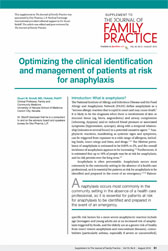Anaphylaxis is a serious, systemic allergic reaction that is rapid in onset and can cause death. Anaphylaxis often occurs in the absence of a health care professional, so it is essential for patients at risk for anaphylaxis to be identified and prepared in the event of an emergency. Identifying at-risk patients goes beyond a history of anaphylaxis; it is important to identify patients who may be at risk for a more severe anaphylactic reaction. Patients at risk for anaphylaxis should be provided an epinephrine auto-injector and appropriately trained in its use in the community setting.

Medical Education Library
Optimizing the clinical identification and management of patients at risk for anaphylaxis
J Fam Pract. 2010 August;59(8):S1-S8
This supplement was sponsored by Dey Pharma, L.P. Medical Exchange International provided editorial support to Dr. Stuart Stoloff.

